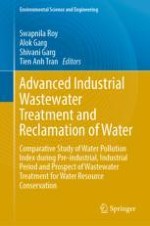2022 | OriginalPaper | Buchkapitel
9. Science and Technology Roadmap for Adsorption of Metallic Contaminants from Aqueous Effluents Using Biopolymers and Its’ Derivatives
verfasst von : Ahmed Elsayid Ali, Zaira Zaman Chowdhury, Rahman F. Rafique, Rabia Ikram, Abu Nasser Mohammad Faisal, ShahJalal Shibly, Arnab Barua, Yasmin Abdul Wahab, Badrul Mohamed Jan
Erschienen in: Advanced Industrial Wastewater Treatment and Reclamation of Water
Aktivieren Sie unsere intelligente Suche, um passende Fachinhalte oder Patente zu finden.
Wählen Sie Textabschnitte aus um mit Künstlicher Intelligenz passenden Patente zu finden. powered by
Markieren Sie Textabschnitte, um KI-gestützt weitere passende Inhalte zu finden. powered by
